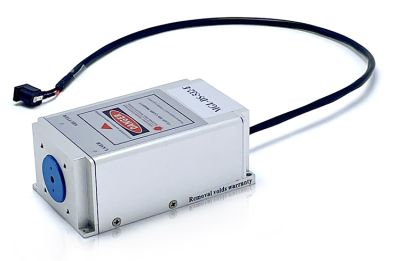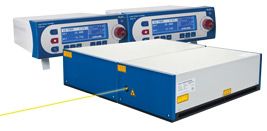green lasers (original) (raw)
Definition: lasers emitting in the green spectral region
Category:  laser devices and laser physics
laser devices and laser physics
- lasers
- visible lasers
* red lasers
* yellow and orange lasers
* green lasers
* blue lasers
- visible lasers
Related: laserslaser diodesfrequency doublingintracavity frequency doublingblue lasersred lasersyellow and orange lasersvisible laserstitanium–sapphire lasersDangerous Green Laser PointersLaser Pointers in Soccer Games: Not Necessarily HarmlessMiniature Laser Projectors – The Next Big Laser Thing?
Page views in 12 months: 2406
DOI: 10.61835/lcy Cite the article: BibTex BibLaTex plain textHTML Link to this page! LinkedIn
Content quality and neutrality are maintained according to our editorial policy.
📦 For purchasing green lasers, use the RP Photonics Buyer's Guide — an expert-curated directory for finding all relevant suppliers, which also offers advanced purchasing assistance.
Contents
What are Green Lasers?
This article concerns lasers emitting in the green spectral region, i.e., with a wavelength roughly around 510–570 nm. The choice of laser gain media for such wavelengths is limited, and the performance achievable is typically not as good as e.g. in the infrared spectral region. Nevertheless, green-emitting lasers of various kinds belong to the most often used visible lasers. Some of them are based on nonlinear frequency conversion, namely frequency doubling.
Types of Green Lasers
There are many types of green lasers, which differ substantially e.g. in terms of output power, pulse format and cost:
- Argon ion lasers, based on amplification in an argon plasma (made with an electrical discharge), are fairly powerful light sources for various wavelengths. The highest power can be achieved in green light at 514.5 nm. It can exceed 20 W, but the power efficiency of such lasers is very poor, so that tens of kilowatts of electric power are required for multi-watt green output, and the cooling system has corresponding dimensions. There are smaller tubes for air-cooled argon lasers, requiring hundreds of watts for generating some tens of milliwatts. The beam quality can be close to diffraction-limited.
- helium–neon lasers are most well known as red lasers, but they can also be made to emit a few milliwatts at 543.5 nm.
- Copper vapor lasers can emit relatively high powers at 510.6 nm. They are based on a pulsed discharge in copper vapor and emit nanosecond pulses.
- Green laser diodes (or other green semiconductor lasers) are difficult to produce – even more difficult than blue ones. They can emit only a few milliwatts and have relatively short lifetimes, compared with other laser diodes [5]. However, there has been encouraging progress recently [10, 11].
- Erbium-doped upconversion lasers based on erbium-doped fibers or bulk crystals can emit around 550 nm, typically with some tens of milliwatts of output power and with high beam quality.
- Praseodymium-doped lasers can emit green light (e.g., Pr3+:YLF at 523 nm), apart from light at various other wavelengths. They can be pumped with blue light from laser diodes, for example.

Figure 1: Photograph of the VERDI green laser from Coherent. This device contains a diode-pumped vanadate laser with intracavity frequency doubling. The image was kindly provided by Coherent.
- There are various types of frequency-doubled solid-state lasers, where the actual laser emits in the 1-μm spectral region and a frequency doubler (based on a nonlinear crystal material such as LiNbO3, LBO or KTP) converts this radiation into green light. The frequency doubling process can take place either outside the laser or within the resonator. Most common is an output wavelength of 532 nm, obtained by doubling 1064-nm radiation from a neodymium-doped 1064-nm Nd:YAG laser or Nd:YVO4 laser, and 515 nm from doubling the output of a 1030-nm Yb:YAG laser. Figure 1 shows an example. Output powers of multiple watts can be easily obtained, even with single-frequency operation and high beam quality. Hundreds of watts of green light are generated with some high-power lasers. Fiber lasers are also interesting sources, in particular when their ability to produce somewhat different wavelengths is relevant. For smaller powers, frequency-doubled microchip lasers or laser diodes (e.g. for green laser pointers) can be used (sometimes with pulsed pumping or with a semiconductor optical amplifier for increased power efficiency of the frequency doubler).
- High-power optically pumped VECSELs are also very attractive laser sources for frequency doubling with several watts or even tens of watts of output power [8]. For lower powers, semiconductor DFB lasers can be used. Note that other kinds of semiconductor lasers, such as broad area laser diodes, are less suitable for frequency doubling due to a typically broader linewidth and poor beam quality.
- There are dye lasers which can be operated in the green spectral region with wide tunability.

Figure 2: A high-power thin disk laser with intracavity frequency doubling generates 1.3 kW of green light with excellent efficiency. Source: Max Kovalenko, Institut für Strahlwerkzeuge, Stuttgart.
Applications
Green lasers are used e.g. as laser pointers, for laser projection displays (as part of RGB sources), for printing, in interferometers, bioinstrumentation, medical scanning, and for pumping of solid-state lasers (e.g. titanium–sapphire lasers).
In laser material processing, green lasers (when compared with near-infrared lasers) can bring benefits via a much higher absorption coefficient e.g. in copper, gold, or silicon. That way, one can work with substantially less laser power, and the processing results are also often substantially better in terms of quality. Therefore, the substantially higher cost per watt is often well justified.
Frequently Asked Questions
This FAQ section was generated with AI based on the article content and has been reviewed by the article’s author (RP).
What is a green laser?
A green laser is a laser that emits light in the green spectral region, which corresponds to a wavelength range of roughly 510 nm to 570 nm.
How is the common 532-nm green laser light generated?
Besides frequency doubling, what other types of green lasers exist?
Green laser light can also be generated directly by various other laser types, including argon ion lasers (at 514.5 nm), erbium-doped upconversion lasers (around 550 nm), and praseodymium-doped lasers (e.g. at 523 nm).
What are the characteristics of green laser diodes?
Green laser diodes are challenging to produce and historically have had relatively short lifetimes and low output powers compared to other laser diodes, although there has been significant progress.
What are some important applications of green lasers?
Green lasers are used in many areas, including as laser pointers, for laser projection displays, in bioinstrumentation and medical scanning, and for pumping other lasers like titanium–sapphire lasers.
Why are green lasers advantageous for material processing?
For certain materials like copper, gold, or silicon, green light has a much higher absorption coefficient than infrared light. This allows for more efficient processing with less laser power and often yields higher-quality results.
Suppliers
Sponsored content: The RP Photonics Buyer's Guide contains 138 suppliers for green lasers. Among them:
⚙ hardware
CNI offers different kinds of green lasers, including both diode lasers and diode-pumped solid-state lasers:
- Green diode lasers are available with wavelengths of 505 nm, 510 nm, 514.5 nm and 520 nm.
- Pulsed solid-state green lasers offer a narrow pulse width of <0.8 ns and pulse energies >450 mJ. We also have high-power versions with >200 W, highly stabilized lasers with <0.1% stability and <0.25% RIN, and single longitudinal mode green lasers with a line width <0.00001 nm.
Our green lasers are widely used in holographic photography, PIV particle velocity, Raman spectra, Lidar and other fields.
⚙ hardware
Nonlinear frequency conversion techniques access wavelengths that cannot be generated directly from laser diode technology. Via second or fourth harmonic generation, TOPTICA laser systems can access the UV, blue, green, yellow and orange spectral ranges at high powers. TOPTICA offers tunable, single-frequency systems at virtually any wavelength between 190 nm and 780 nm, employing ultrastable seed lasers, power amplification in semiconductor or fiber amplifiers, and a proprietary bow-tie cavity design — all in established pro technology.
⚙ hardware
The latest release, PicoSpear Amplified Microchip Series, produces ultra-short pulses, as short as 650 picoseconds, and maintains a high output power adjustable up to 500 mW.
Compact models of the passively Q-switched range, such as the SNG-40F-1x0 laser, with average output powers between 15 mW and 100 mW and different pulse repetition rates.
Triggered lasers include the STG-03E-1x0 laser, a short pulse laser available also with green output.
⚙ hardware
APS offers the MicroGreen™ Series, which is a diode-pumped solid-state laser packaged in a 5.6 mm diameter can. The MicroGreen is available in power ratings up to 80 mW in TEM00 mode. The alignment-free optical design is also both rugged and reliable; and its high optical-to-optical conversion efficiency allows the laser to be battery powered. Applications include tool alignment, machine vision, aiming guide, and the green color source in micro-displays.
⚙ hardware
Osela's green laser products combine high visibility with excellent beam quality for versatile machine vision, bioinstrumentation, visual alignment applications. Typically operating around 520 nm, our green lasers offer a balance between the resolution advantages of blue lasers and the lower power requirements of red lasers. These modules are particularly well-suited for applications such as DNA sequencing, fluorescence microscopy, and industrial alignment. Featuring Osela's proprietary beam shaping technology, our green lasers can be customized with various output patterns and power levels to meet the diverse needs of OEM integrators and end-users in both life sciences and industrial sectors.
⚙ hardware
Sacher Lasertechnik has developed a frequency-doubled laser system where a resonant cavity including a frequency doubler crystal is pumped via a tunable diode laser. Depending on the required SHG power, the tunable diode laser is either a high power external cavity laser, or a two stage Master Oscillator Power Amplifier System. The covered wavelength regime ranges from 365 nm up to 540 nm.
⚙ hardware

VEXLUM offers VECSEL technology with intracavity frequency doubling, producing diffraction-limited, watt-level lasers across the green spectral region (500–570 nm). The lasers feature a wavelength tuning range of ±1 nm and a narrow linewidth, ideal for various applications:
Quantum technology:
- Cs Rydberg state preparation 509 nm
- Yb macic wavelength 552 nm
- Ba MOT 553.5 nm
- Yb 2nd stage narrow cooling 556 nm
- Yb clock 578 nm
Medical applications:
- Ophthalmology: retinal photocoagulation (520 or 532 nm)
⚙ hardware
Serving North America, RPMC Lasers offers high-performance pulsed, CW, and diode green lasers at 520, 532, 543, and 554 nm, delivering excellent visibility even in sunlight, with 10-50x brighter output than red lasers for high-contrast, long-range use at lower power and cost.
Efficient light-matter interactions outshine IR lasers, providing higher absorption in metals like copper, gold, and aluminum, with smaller spot sizes and reduced HAZ for superior cuts and marks in processing applications.
Our wide range spans DPSS, HeNe, microchip, and diode technologies, from components to OEM integration, with configurable platforms and price points to suit industrial, scientific, and custom needs.
Let RPMC help you find the right green laser today!
⚙ hardware
Monocrom offers different green lasers:
- Multi-Path 532: a photocoagulation laser emitting up to 8 W cw or 15 W qcw at 532 nm
- CiOM lasers emitting nanosecond pulses at 526.5 nm
⚙ hardware
HÜBNER Photonics specializes in providing high-quality green diode-pumped lasers (DPLs) that emit at 532 nm. These lasers are designed for single longitudinal mode operation, ensuring very low noise and excellent power stability. Key features include:
- Emission at 532 nm
- Single longitudinal mode operation
- Very low noise levels
- Excellent power stability
- 24-month warranty
For more detailed specifications and potential applications, visit the HÜBNER Photonics website.
Bibliography
| [1] | A. J. Silversmith et al., “Green infrared-pumped erbium upconversion laser”, Appl. Phys. Lett. 51, 1977 (1987); doi:10.1063/1.98316 |
|---|---|
| [2] | F. Tong et al., “551 nm diode-laser-pumped upconversion laser”, Electron. Lett. 25, 1389 (1989); doi:10.1049/el:19890930 |
| [3] | T. Hebert et al., “Blue and green CW upconversion lasing in Er:YLiF4”, Appl. Phys. Lett. 57, 1727 (1990); doi:10.1063/1.104048 |
| [4] | T. J. Whitley et al., “Upconversion pumped green lasing in erbium doped fluorozirconate fibre”, Electron. Lett. 27 (20), 1785 (1991); doi:10.1049/el:19911110 |
| [5] | E. Kato et al., “Significant progress in II-VI blue-green laser diode lifetime”, Electron. Lett. 34, 282 (1998); doi:10.1049/el:19980229 |
| [6] | L. McDonagh and R. Wallenstein, “Low-noise 62 W CW intracavity-doubled TEM00 Nd:YVO4 green laser pumped at 888 nm”, Opt. Lett. 32 (7), 802 (2007); doi:10.1364/OL.32.000802 |
| [7] | C. Stolzenburg et al., “Cavity-dumped intracavity-frequency-doubled Yb:YAG thin-disk laser with 100 W average power”, Opt. Lett. 32 (9), 1123 (2007); doi:10.1364/OL.32.001123 |
| [8] | J.-Y. Kim et al., “Highly efficient green VECSEL with intra-cavity diamond heat spreader”, Electron. Lett. 43 (2), 105 (2007); doi:10.1049/el:20072787 |
| [9] | O. B. Jensen et al., “1.5 W green light generation by single-pass second harmonic generation of a single-frequency tapered diode laser”, Opt. Express 17 (8), 6532 (2009); doi:10.1364/OE.17.006532 |
| [10] | T. Miyoshi et al., “510–515 nm InGaN-based green laser diodes on c-plane GaN substrate”, Appl. Phys. Express 2, 062201 (2009); doi:10.1143/APEX.2.062201 |
| [11] | H. Ohta et al., “Future of group-III nitride semiconductor green laser diodes”, J. Opt. Soc. Am. B 27 (11), B45 (2010); doi:10.1364/JOSAB.27.000B45 |
| [12] | T. Meier et al., “Continuous-wave single-frequency 532 nm laser source emitting 130 W into the fundamental transversal mode”, Opt. Lett. 35 (22), 3742 (2010); doi:10.1364/OL.35.003742 |
| [13] | R. Cieslak and W. A. Clarkson, “Internal resonantly enhanced frequency doubling of continuous-wave fiber lasers”, Opt. Lett. 36 (10), 1896 (2011); doi:10.1364/OL.36.001896 |
| [14] | R. Bhandari and T. Taira, “>6 MW peak power at 532 nm from passively Q-switched Nd:YAG/Cr4+:YAG microchip laser”, Opt. Express 19 (20), 19135 (2011); doi:10.1364/OE.19.019135 |
| [15] | H. Chi et al., “Demonstration of a kilowatt average power, 1 J, green laser”, Opt. Lett. 45 (24), 6803 (2020); doi:10.1364/OL.412975 |
(Suggest additional literature!)
Questions and Comments from Users
Here you can submit questions and comments. As far as they get accepted by the author, they will appear above this paragraph together with the author’s answer. The author will decide on acceptance based on certain criteria. Essentially, the issue must be of sufficiently broad interest.
Please do not enter personal data here. (See also our privacy declaration.) If you wish to receive personal feedback or consultancy from the author, please contact him, e.g. via e-mail.
By submitting the information, you give your consent to the potential publication of your inputs on our website according to our rules. (If you later retract your consent, we will delete those inputs.) As your inputs are first reviewed by the author, they may be published with some delay.


















